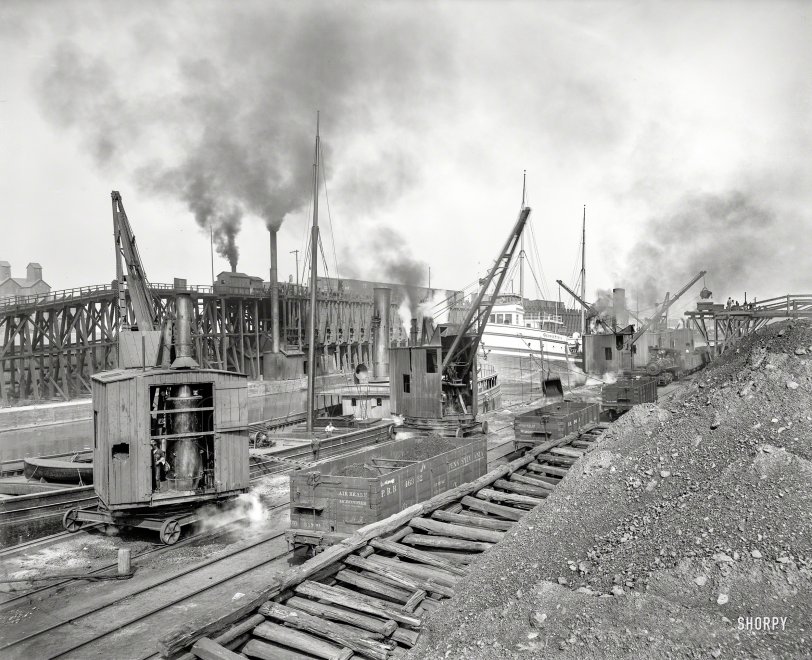


Framed or unframed, desk size to sofa size, printed by us in Arizona and Alabama since 2007. Explore now.
Shorpy is funded by you. Patreon contributors get an ad-free experience.
Learn more.

- Details, Details
- What's that building to the left of the tower?
- Coal Barges
- Bromo-Seltzer
- Inner harbor
- The Basin
- What a headache!
- Giant stepladder?
- Baldwin 62303
- Baldwin VO-1000
- Cold
- No expense spared
- Tough Guys
- Lost in Toyland
- And without gloves
- If I were a blindfolded time traveler
- Smoke Consumer Also Cooks
- Oh that stove!
- Possibly still there?
- What?!?
- $100 Reward
- Freeze Frame
- Texas Flyer wanted
- Just a Year Too Soon
- WWII -- Replacing men with women at the railroad crossing.
- Yes, Icing
- You kids drive me nuts!
- NOT An Easy Job
- I wonder
- Just add window boxes
Print Emporium
Whirleys Unloading: 1900

Circa 1900. "Whirleys unloading ore, Penna. R.R. docks, Erie, Pennsylvania." 8x10 inch dry plate glass negative, Detroit Publishing Company. View full size.
Compromise Couplers.
The interesting automatic couplers here were called "Compromise" type. Though the automatic (janey) coupler had been adopted by the ICC (now FRA) at the time of the photo, many railroads had some difficulty converting their rolling stock over. To compromise, the split face coupler was designed. This allowed the link of the old "link and pin" type coupler to be slipped through the split face and fastened in place with a pin dropped through a hole in the top of the coupler.
What's happening on the trestle?
There is a trestle behind the "whirleys" with some box cars on it. It appears that whatever is on the box cars can be unloaded (by hand or by shovel) and dropped down a chute to a building under the trestle. I wonder what commodity that was, and why it wasn't shipped in gondolas (open-topped cars) like the ore in the foreground. Maybe it's something that they needed relatively less of in the process, or maybe the trestle dates to a time when everything was shipped in a boxcar.
Clyde Iron Works of Duluth
Building a wide assortment of Whirley cranes since 1889.
Safety First
Adoption of the Westinghouse Air Brake and the Master Car Builders Association (MCB)Coupler (based on the Janney patents) are credited with reducing the worker fatalities on early American railroads. Air brakes by reducing the need for workers to walk the tops of the cars applying hand brakes and the coupler the need for workers to get between the cars for coupling and uncoupling.
"George Stone"
#75 on the map. http://www.alcheminc.com/huron.html
I remember as a kid growing up in Leamington in the 1950s seeing lots of sunken ship artifacts in the waters around Point Pelee especially when lake levels were down.
Sink like a Stone.
Fascinating.
Sadly, the steamer George Stone would be lost off Point Pelee, Ontario, in a storm 9 years later, at the cost of 6 lives.
























On Shorpy:
Today’s Top 5